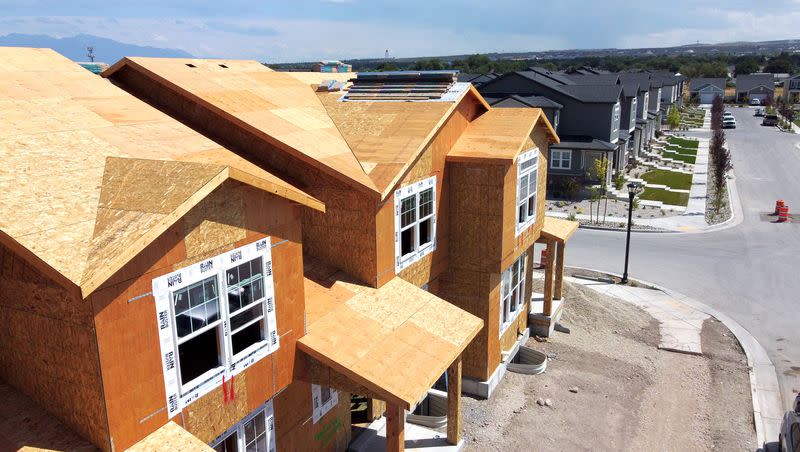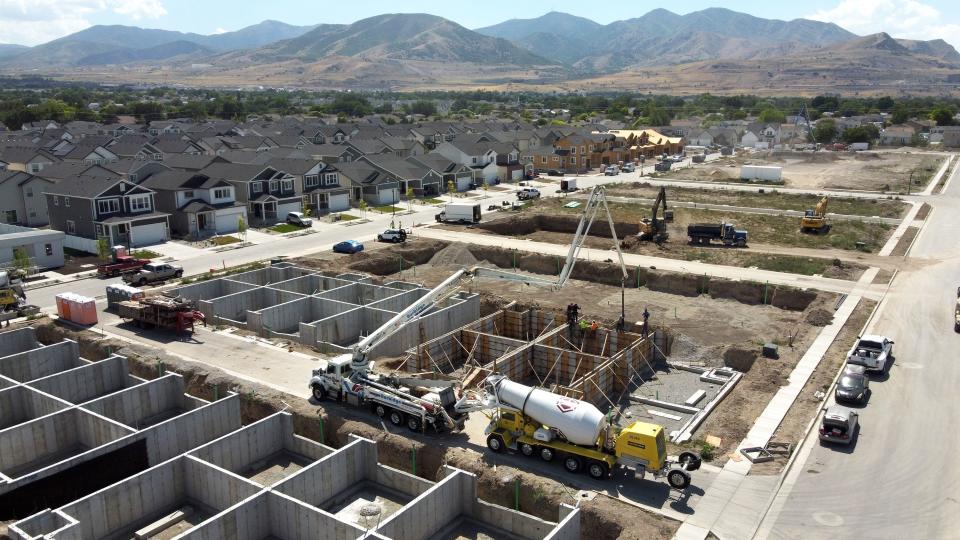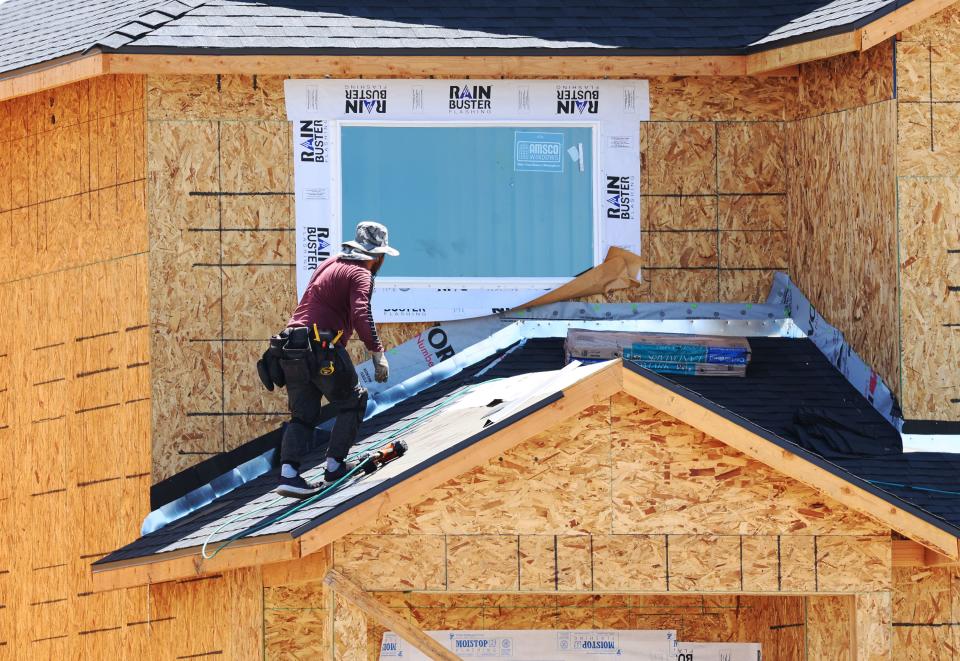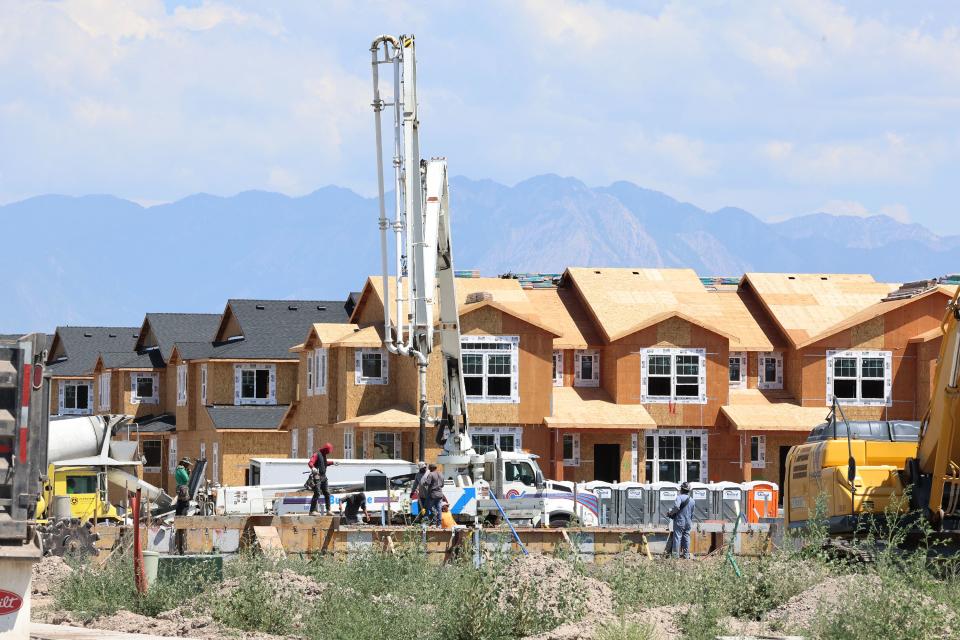Homebuilders ‘only game in town’ as sales of existing homes slow down

When the housing market took a turn for the worse last year amid rapidly rising mortgage rates, Clark Ivory, CEO of one of Utah’s largest homebuilders, braced for a slowdown.
Heading into 2023, Ivory Homes laid off 9% of its staff (keeping core management intact) and cut housing starts by about 80% from its peak (down from 143 in June 2022 to 30 in January). It was in anticipation of a hangover from the sugar high that was the first half of 2022, when the market was at the height of the pandemic housing frenzy.
But then, spring came along. And Ivory has been pleasantly surprised.
“The first half of the year was a lot stronger than what I’d anticipated,” he said.
While the company’s home sales are still tracking lower than last year’s hectic cycle — which closed at about $750 million — it’s on pace to close out 2023 at about $550 million to $575 million — higher than the $525 million Ivory expected.
Even though the real estate market remains sluggish compared to wild 2020, 2021 and early 2022, there is a silver lining for homebuilders like Ivory. Thanks to the lock-in effect — with millions of U.S. homeowners reluctant to sell and give up their low mortgage rates — new home sales have found a unique foothold, outpacing existing home sales.
Related
New home sales surged this spring, accounting for almost a third of single-family dwellings for sale in the U.S. in May, compared to a historical norm of 10% to 20%, The Wall Street Journal reported. In June, existing home sales dropped almost 19% year over year, according to the National Association of Realtors. Meanwhile, new single-family home sales in June rose almost 24% year over year, according to the estimates released jointly by the U.S. Census Bureau and the Department of Housing and Urban Development.
“(Homeowners) aren’t selling their homes, so the only game in town are the homebuilders,” said Dejan Eskic, senior research fellow and scholar at the University of Utah’s Kem C. Gardner Policy Institute and chief economist at the Salt Lake Board of Realtors. Typically, homebuilders compete with homeowners, but now “in Utah there’s 25% less competition to sell a home.”

It’s an interesting phenomenon playing out nationally that’s hitting close to home in Utah, a rapidly growing state that has struggled with a persistent housing shortage even before the COVID-19 housing madness overheated the market in the West. In Salt Lake County, Utah’s most populated county, the median single-family home price jumped nearly 60% from March 2020 to May 2022, when it peaked at $650,000, according to the Salt Lake Board of Realtors. Then median home prices dropped, bottoming in January at $535,700, a more than 17% reduction.
But prices have started climbing again since then. In June of this year, the median single-family Salt Lake County home sold for $600,000, a nearly 8% year-over-year reduction but a 12% increase from January.
Still, home prices in Utah are high. The state continues to grapple with a housing shortage, so demand persists, despite affordability issues. Coupled with mortgage rates over 6% and 7%, depending on the day, many would-be homebuyers continue to be priced out of the market.
Related
That is where large homebuilders like Ivory Homes — builders who can afford it — are getting creative and finding ways to sell.
Yes, homebuilders cut prices — but Ivory Homes made only incremental discounts, Ivory said. The biggest focus, he said, has been on offering financial incentives and assistance, including rate buy-downs and paying closing costs to help buyers stomach their monthly payments.
“It’s great news that you know, we’ve gone from being 15% of overall sales to over 30%,” Ivory said. “So we’re a much bigger part of the solution for people who are looking for housing.”

Last summer, when sales began to pull back amid rising rates, Ivory said his company “got really aggressive and said, ‘The only way we’re going to be able to manage this and not reduce pricing substantially is to do more to help people to get better rates.’ And that’s when we started to buy forward commitments with 30-year fixed rates. So these are not temporary buy-downs, but what you call a permanent buy-down on the interest rate.”
In late 2022 and early 2023, Ivory said Ivory Homes was able to buy rates down to a 4.875% fixed rate. On a $500,000 mortgage, that rate buy-down would cost Ivory Homes about $25,000 to $30,000. Still, that’s less than it would cost to discount the home to the same monthly payment for a homebuyer at a higher interest rate, Ivory said.
Now, as mortgage rates rise again, some days over 7%, Ivory said he recently bought more forward commitments, and he’s able to offer rates as low as 5.375%.
“It’s a smart thing to do,” he said. “It’s a much bigger cost (to discount) if I’m trying to hit a certain (monthly) payment.”
In June 2022, Ivory Homes had 1,053 houses under construction. In July, that number dropped to 641. “Yeah, we pulled back,” he said, but added that Ivory Homes is “completing more homes than we have started,” and the company has been able to increase the speed in which it finishes homes, no longer grappling with intense supply chain issues that plagued builders during the pandemic.
Overall, Ivory said it’s good news that Utah’s housing market in general is adjusting.
“It’s not red hot,” he said. “But I like it better that way. It’s more stable, more predictable. ... It’s easier to produce, quality, timing, everything else. It’s easier for us to live up to buyer expectations. All of that stuff is better when the market is more stable.”
Eskic said that strategy is paying off for large homebuilders like Ivory Homes, but smaller builders that don’t have as much flexibility to buy down rates aren’t doing as well. Even though builders like Ivory are finding ways to make the most of a slower market, the slowdown has still taken its toll — and that’s not good news for Utah’s housing shortage.
#Utah 's housing shortage improved over the last 2 yrs. But I expected it to worsen over the next 2 yrs. #utpol #utecon pic.twitter.com/cWY1E7hpwC
— Dejan Eskic (@EskicDejan) June 30, 2023
Even though Utah saw a housing boom over the last several years as builders raced to keep up with runaway demand, the contraction will have long-term impacts on housing availability and affordability for Utahns. Eskic said he expects Utah’s housing shortage to worsen over the next two years.
“We’re seeing a 25% to 30% decline in construction,” Eskic said. Meanwhile, Utah’s population and household formation is expected to keep growing. That will continue to put pressure on Utah’s housing inventory and therefore its prices.
Heading into 2024, mortgage rates are expected to come down, and “it will be very interesting to see how that plays out on housing prices” next year, Eskic said. Previously, housing experts have said they expect home prices to taper in 2023, then bounce back steadily in 2024. The big question is whether the country will enter a recession. That all depends on if the Federal Reserve can successfully slow inflation without going too far and tipping the economy into a decline.
Related
All the while, Eskic expects homeowners in Utah to hold onto their homes well into the future, even if mortgage rates tip down. He said the Utah housing market has become somewhat like a coastal market, in that it’s become a desirable destination to own a home, not just for its economy and job market, but also because it’s an investment that can be used as a rental property.
“People who have a piece of real estate (in Utah), they’re not going to get rid of it,” Eskic said. “They see we’re growing. It’s a good place to live. The reason to move out of Utah in the current economic and social environment, it’s really difficult to justify.”
Ivory acknowledged there is still work to do to tackle Utah’s housing affordability issues. Recently, he focused on building townhouses to offer homes at lower price points, but he said accessory dwelling units and other housing types should also be part of the solution, including building more affordable single-family detached homes.
“I think a $500,000 family detached home is a greater accomplishment than a $400,000 townhome to contribute to affordability,” Ivory said. “We need to do both.”
Related


